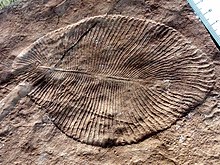| Dickinsonia Temporal range: Late Ediacaran,
| |
|---|---|

| |
| Cast of Dickinsonia costata from Australia | |
| Scientific classification | |
| Domain: | Eukaryota |
| Kingdom: | Animalia |
| Phylum: | †Proarticulata |
| Class: | †Dipleurozoa |
| Family: | †Dickinsoniidae |
| Genus: | †Dickinsonia Sprigg, 1947 |
| Type species | |
| †Dickinsonia costata Sprigg, 1947
| |
| Species | |
| |
| Synonyms | |
|
Genus synonymy D. costata synonymy
D. tenuis synonymy
| |
Dickinsonia is a genus of extinct organism, most likely an animal, that lived during the late Ediacaran period in what is now Australia, China, Russia, and Ukraine. It is one of the best known members of the Ediacaran biota. The individual Dickinsonia typically resembles a bilaterally symmetrical ribbed oval. Its affinities are presently unknown; its mode of growth has been considered consistent with a stem-group bilaterian affinity,[3] though various other affinities have been proposed.[4][5][6] It lived during the late Ediacaran (final part of Precambrian).[7] The discovery of cholesterol molecules in fossils of Dickinsonia lends support to the idea that Dickinsonia was an animal,[8] though these results have been questioned.[9]
- ^ Hofmann, Hans J. (1988). "An alternative interpretation of the Ediacaran (Precambrian) chondrophore Chondroplon (Wade)". Alcheringa. 12 (4): 315–318. doi:10.1080/03115518808619130.
- ^ Cite error: The named reference
Ivantsov2007was invoked but never defined (see the help page). - ^ Gold, D.A.; Runnegar, B.; Gehling, J.G.; Jacobs, D.K. (2015). "Ancestral state reconstruction of ontogeny supports a bilaterian affinity for Dickinsonia". Evolution & Development. 17 (6): 315–397. doi:10.1111/ede.12168. PMID 26492825. S2CID 26099557.
- ^ Pflug (1973). "Zur fauna der Nama-Schichten in Südwest-Afrika. IV. Mikroscopische anatomie der petalo-organisme" [On the fauna of the Nama layers in southwest Africa. [part] IV. Microscopic anatomy of petaloorganisms]. Palaeontographica (B144): 166–202.
- ^ Seilacher, Adolf (1992). "Vendobionta and Psammocorallia: Lost constructions of Precambrian evolution". Journal of the Geological Society, London. 149 (4): 607–613. Bibcode:1992JGSoc.149..607S. doi:10.1144/gsjgs.149.4.0607. S2CID 128681462. Retrieved 21 June 2007.
- ^ McMenamin, M. (1998). The Garden of Ediacara. New York: Columbia University Press. ISBN 978-0-231-10559-0. OCLC 228271905.
- ^ Dinosaurs: A visual encyclopedia. New York, NY: DK Publishing. 3 April 2018. ISBN 9781465469489.
- ^ Bobrovskiy, Ilya; Hope, Janet M.; Ivantsov, Andrey; Nettersheim, Benjamin J.; Hallmann, Christian; Brocks, Jochen J. (20 September 2018). "Ancient steroids establish the Ediacaran fossil Dickinsonia as one of the earliest animals". Science. 361 (6408): 1246–1249. Bibcode:2018Sci...361.1246B. doi:10.1126/science.aat7228. hdl:1885/230014. PMID 30237355.
- ^ Love, G.D.; Zumberge, J.A. (2021). "Emerging patterns in Proterozoic lipid biomarker records". Cambridge Elements. 361 (6408). doi:10.1017/9781108847117. ISBN 9781108847117.